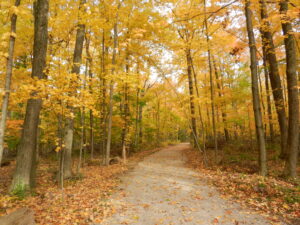B y Rich Niccum, Education Services Manager

I am always in awe of a clear night sky filled with millions of stars, planets, and more. Living in the city as I do, I am surrounded by lights, so what I get to see is nothing compared to what I get to see when I am in one of the parks like Blues Creek or Gallant Woods. As I look up on a clear night, my jaw drops and I am utterly transfixed on the heavens. In addition to a normal night of stargazing, there are many astronomical events throughout the year as well. 2020 has been a year from the underworld, but it will end on a high note, astronomically speaking, with two special events in the skies overhead.
Early December is a good time to see the Geminids meteor shower. This shower is one of the more spectacular ones, and runs from December 4 – 17, with the peak on December 14. What makes this shower so spectacular is that the meteors are often bright, with intense colors, and they tend to be a little slower than normal. This particular shower is generated by debris from an asteroid designated 3200 Phaethon. What will make the Geminids even more visible this year, clear skies willing, is a new moon on December 14. The best time to view the Geminids on the 14th, will be in full darkness on Sunday night until dawn on Monday morning. So, if you are not a night owl you will still get to see some, but if you can stay up to 2:00 a.m., the densest part of the debris field will be directly above, and you will get to see the peak at what is projected to be up to 120 meteors per hour.

The other highlight this December, and one that won’t occur for another 60 years is what is called the “Great Conjunction of Jupiter and Saturn.” Not since July 1623 have the two planets appeared this close, however they were not likely seen by anyone as they were too close to the sun. You have to go back to March 1226 before they would have possibly been seen by human eyes. This celestial meetup is underway now, but the two will be closest on the evening of December 21, where they will appear as one bright object in the southwest sky after sunset. Of course, while they appear close, they will still actually be hundreds of millions of miles apart. If you set up a telescope or a strong pair of binoculars, in your backyard or local park, following all regulations for open hours of course, you will see them both in your field of view, and visible as two separate objects. If you happen to miss them on December 21 don’t fret as they are close together for a week before and after their official meetup.

With everything that has happened to us in 2020, take some time to enjoy some cosmic fireworks and a planetary meetup, and end your year on an astronomical high note! If you would like to learn more about monthly astronomical events, check out https://www.space.com/skywatching for their excellent monthly guide. Also check out https://blogs.nasa.gov/Watch_the_Skies/ for tips and more to watching the night sky. Happy holidays and merry stargazing!






